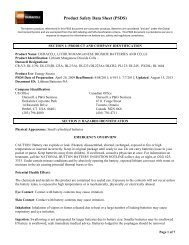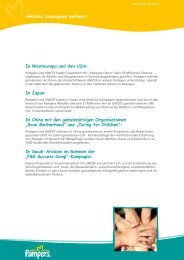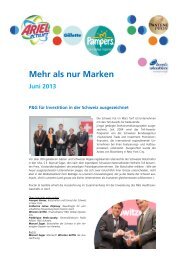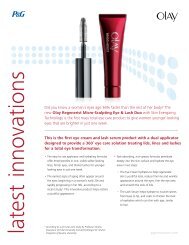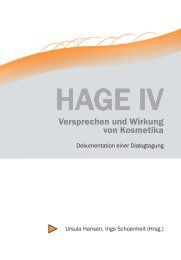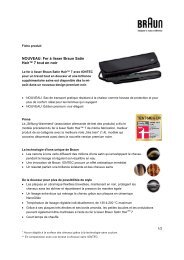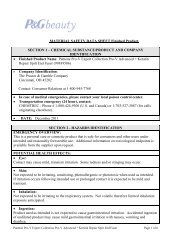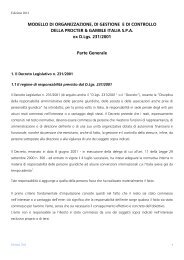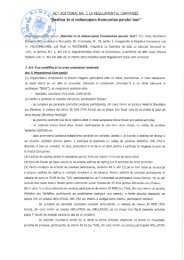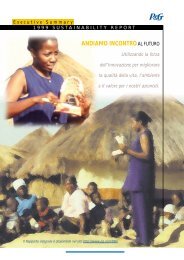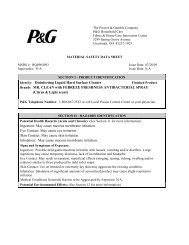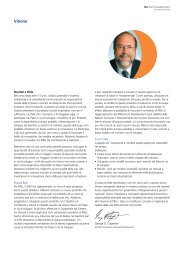P&G 2009 Annual Report – AnnualReports.com - Procter & Gamble
P&G 2009 Annual Report – AnnualReports.com - Procter & Gamble
P&G 2009 Annual Report – AnnualReports.com - Procter & Gamble
You also want an ePaper? Increase the reach of your titles
YUMPU automatically turns print PDFs into web optimized ePapers that Google loves.
48 The <strong>Procter</strong> & <strong>Gamble</strong> Company Management’s Discussion and Analysis<br />
rate movements on our investments in foreign operations. These<br />
currency interest rate swaps are designated as hedges of the Company’s<br />
foreign net investments.<br />
Based on our overall interest rate exposure as of and during the year<br />
ended June 30, <strong>2009</strong>, including derivative and other instruments<br />
sensitive to interest rates, we believe a near-term change in interest<br />
rates, at a 95% confidence level based on historical interest rate<br />
movements, would not materially affect our financial statements.<br />
Currency Rate Exposure on Financial Instruments. Because we<br />
manufacture and sell products in a number of countries throughout<br />
the world, we are exposed to the impact on revenue and expenses of<br />
movements in currency exchange rates. The primary purpose of our<br />
currency hedging activities is to reduce the risk that our financial<br />
position will be adversely affected by short-term changes in exchange<br />
rates. Corporate policy prescribes the range of allowable hedging<br />
activity. We primarily use forward contracts with maturities of less than<br />
18 months. In addition, we enter into certain currency swaps with<br />
maturities of up to five years to hedge our exposure to exchange rate<br />
movements on inter<strong>com</strong>pany financing transactions.<br />
Based on our overall currency rate exposure as of and during the year<br />
ended June 30, <strong>2009</strong>, we believe, at a 95% confidence level based<br />
on historical currency rate movements, the impact of a near-term<br />
change in currency rates on derivative and other instruments would<br />
not materially affect our financial statements.<br />
Commodity Price Exposure on Financial Instruments. We use raw<br />
materials that are subject to price volatility caused by weather, supply<br />
conditions, political and economic variables and other unpredictable<br />
factors. In addition to fixed price contracts, we use futures, options<br />
and swap contracts to manage the volatility related to the above<br />
exposures.<br />
Based on our overall <strong>com</strong>modity price exposure as of and during the<br />
year ended June 30, <strong>2009</strong>, we believe, at a 95% confidence level<br />
based on historical <strong>com</strong>modity price movements, the impact of a<br />
near-term change in <strong>com</strong>modity prices on derivative and other<br />
instruments would not materially affect our financial statements.<br />
Measures Not Defined By U.S. GAAP<br />
Our discussion of financial results includes several “non-GAAP”<br />
financial measures. We believe these measures provide our investors<br />
with additional information about our underlying results and trends, as<br />
well as insight to some of the metrics used to evaluate management.<br />
When used in MD&A, we have provided the <strong>com</strong>parable GAAP<br />
measure in the discussion. These measures include:<br />
Organic Sales Growth. Organic sales growth measures sales growth<br />
excluding the impacts of foreign exchange, acquisitions and divestitures<br />
from year-over-year <strong>com</strong>parisons. We believe this provides<br />
investors with a more <strong>com</strong>plete understanding of underlying results<br />
and trends by providing sales growth on a consistent basis.<br />
The following tables provide a numerical reconciliation of organic<br />
sales growth to reported net sales growth:<br />
FY <strong>2009</strong><br />
Net Sales<br />
Growth<br />
Foreign<br />
Exchange<br />
Impact<br />
Acquisition/<br />
Divestiture<br />
Impact<br />
Organic<br />
Sales<br />
Growth<br />
Beauty -4% 4% 1% 1%<br />
Grooming -9% 6% 1% -2%<br />
Health Care -7% 5% 1% -1%<br />
Snacks and Pet Care -3% 4% 0% 1%<br />
Fabric Care and Home Care -2% 5% 0% 3%<br />
Baby Care and Family Care 1% 4% 2% 7%<br />
TOTAL P&G -3% 4% 1% 2%<br />
FY 2008<br />
Net Sales<br />
Growth<br />
Foreign<br />
Exchange<br />
Impact<br />
Acquisition/<br />
Divestiture<br />
Impact<br />
Organic<br />
Sales<br />
Growth<br />
Beauty 9% -6% 1% 4%<br />
Grooming 11% -7% 0% 4%<br />
Health Care 9% -5% -1% 3%<br />
Snacks and Pet Care 7% -4% 0% 3%<br />
Fabric Care and Home Care 11% -5% 0% 6%<br />
Baby Care and Family Care 9% -4% 3% 8%<br />
TOTAL P&G 9% -5% 1% 5%<br />
Free Cash Flow. Free cash flow is defined as operating cash flow less<br />
capital spending. We view free cash flow as an important measure<br />
because it is one factor in determining the amount of cash available<br />
for dividends and discretionary investment. Free cash flow is also one<br />
of the measures used to evaluate senior management and is a factor<br />
in determining their at-risk <strong>com</strong>pensation.<br />
Free Cash Flow Productivity. Free cash flow productivity is defined as<br />
the ratio of free cash flow to net earnings. Our target is to generate free<br />
cash flow at or above 90% of net earnings. Free cash flow productivity<br />
is one of the measures used to evaluate senior management and is a<br />
factor in determining their at-risk <strong>com</strong>pensation.<br />
The following table provides a numerical reconciliation of free cash flow:<br />
Operating<br />
Cash Flow<br />
Capital<br />
Spending<br />
Free<br />
Cash Flow<br />
Net<br />
Earnings<br />
Free<br />
Cash Flow<br />
Productivity<br />
<strong>2009</strong> $14,919 $(3,238) $11,681 $13,436 87%<br />
2008 $ 15,008 $ (3,046) $ 11,962 $ 12,075 99%<br />
2007 $ 13,410 $ (2,945) $ 10,465 $ 10,340 101%<br />
2006 $ 11,372 $ (2,667) $ 8,705 $ 8,684 100%<br />
2005 $ 8,561 $ (2,181) $ 6,380 $ 6,923 92%<br />
2004 $ 9,216 $ (2,024) $ 7,192 $ 6,156 117%<br />
2003 $ 8,455 $ (1,482) $ 6,973 $ 4,788 146%<br />
2002 $ 7,672 $ (1,679) $ 5,993 $ 3,910 153%<br />
Total Free Cash Flow Since 2001 $ 69,351<br />
Average Free Cash Flow Productivity 112%



